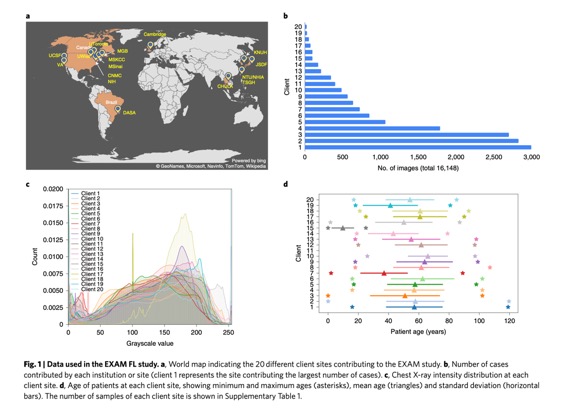Imaging Pearls ❯ Deep Learning ❯ Federated Learning
|
-- OR -- |
|
- “Federated learning (FL) is a method used for training artificial intelligence models with data from multiple sources while main- taining data anonymity, thus removing many barriers to data sharing. Here we used data from 20 institutes across the globe to train a FL model, called EXAM (electronic medical record (EMR) chest X-ray AI model), that predicts the future oxygen require- ments of symptomatic patients with COVID-19 using inputs of vital signs, laboratory data and chest X-rays. EXAM achieved an average area under the curve (AUC) >0.92 for predicting outcomes at 24 and 72 h from the time of initial presentation to the emergency room, and it provided 16% improvement in average AUC measured across all participating sites and an average increase in generalizability of 38% when compared with models trained at a single site using that site’s data. For prediction of mechanical ventilation treatment or death at 24 h at the largest independent test site, EXAM achieved a sensitivity of 0.950 and specificity of 0.882. In this study, FL facilitated rapid data science collaboration without data exchange and generated a model that generalized across heterogeneous, unharmonized datasets for prediction of clinical outcomes in patients with COVID-19, setting the stage for the broader use of FL in healthcare.”
Federated learning for predicting clinical outcomes in patients with COVID-19
Ittai Dayan et al
Nat Med. 2021 Sep 15. doi: 10.1038/s41591-021-01506-3. - “Federated learning (FL) is a method used for training artificial intelligence models with data from multiple sources while main- taining data anonymity, thus removing many barriers to data sharing. Here we used data from 20 institutes across the globe to train a FL model, called EXAM (electronic medical record (EMR) chest X-ray AI model), that predicts the future oxygen require- ments of symptomatic patients with COVID-19 using inputs of vital signs, laboratory data and chest X-rays. EXAM achieved an average area under the curve (AUC) >0.92 for predicting outcomes at 24 and 72 h from the time of initial presentation to the emergency room, and it provided 16% improvement in average AUC measured across all participating sites and an average increase in generalizability of 38% when compared with models trained at a single site using that site’s data.”
Federated learning for predicting clinical outcomes in patients with COVID-19
Ittai Dayan et al
Nat Med. 2021 Sep 15. doi: 10.1038/s41591-021-01506-3. 
Federated learning for predicting clinical outcomes in patients with COVID-19
Ittai Dayan et al
Nat Med. 2021 Sep 15. doi: 10.1038/s41591-021-01506-3.- “Federated learning supports the rapid launch of centrally orchestrated experiments with improved traceability of data and assessment of algorithmic changes and impact. One approach to FL, called client-server, sends an ‘untrained’ model to other servers (‘nodes’) that conduct partial training tasks, in turn sending the results back to be merged in the central (‘federated’) server. This is conducted as an iterative process until training is complete. Governance of data for FL is maintained locally, alleviating privacy concerns, with only model weights or gradients communicated between client sites and the federated server. FL has already shown promise in recent medical imaging applications, including in COVID-19 analysis. A notable example is a mortality prediction model in patients infected with SARS-COV-2 that uses clinical features, albeit limited in terms of number of modalities and scale.”
Federated learning for predicting clinical outcomes in patients with COVID-19
Ittai Dayan et al
Nat Med. 2021 Sep 15. doi: 10.1038/s41591-021-01506-3. - "Recent works on privacy attacks within the FL setting have raised concerns on data leakage during model training. Meanwhile, protection algorithms remain underexplored and constrained by multiple factors. While differential privacy algorithms show good protection, they may weaken the model’s performance. Encryption algorithms, such as homomorphic encryption, maintain performance but may substantially increase message size and training time. A quantifiable way to measure privacy would allow better choices for deciding the minimal privacy parameters necessary while maintaining clinically acceptable performance.”
Federated learning for predicting clinical outcomes in patients with COVID-19
Ittai Dayan et al
Nat Med. 2021 Sep 15. doi: 10.1038/s41591-021-01506-3. - "Following further validation, we envision deployment of the EXAM model in the ED setting as a way to evaluate risk at both the per-patient and population level, and to provide clinicians with an additional reference point when making the frequently difficult task of triaging patients. We also envision using the model as a more sensitive population-level metric to help balance resources between regions, hospitals and departments. Our hope is that similar FL efforts can break the data silos and allow for faster development of much-needed AI models in the near future.”
Federated learning for predicting clinical outcomes in patients with COVID-19
Ittai Dayan et al
Nat Med. 2021 Sep 15. doi: 10.1038/s41591-021-01506-3.
